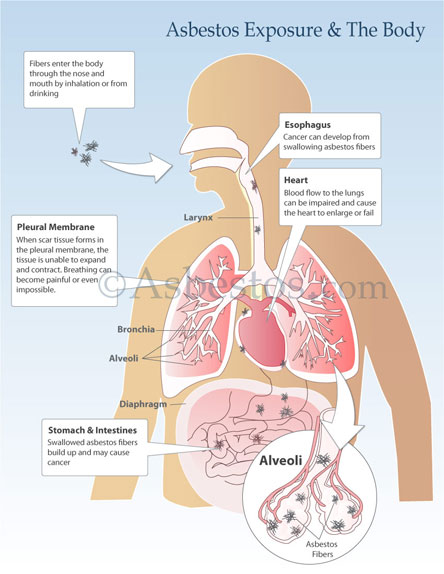Are You at Risk of Asbestos Exposure?
Asbestos exposure is the leading cause of mesothelioma, a rare and incurable asbestos-related cancer that affects nearly 3,000 people each year in the United States; and it can happen anywhere that asbestos is present, at your home, school, office, or your job. “Occupational exposure is the No. 1 cause of asbestos disease. That means roofers, carpenters, electricians, plumbers, firefighters, auto mechanics, insulators, factory workers and many others are at a high risk of exposure.” Other worksites like construction, shipyards, power plants, oil refineries and steel mills, or those who work in the military services are also among those at risk. “U.S. military veterans were the most vulnerable of all — accounting for almost a third of all cases — because of the military’s past reliance on asbestos products, especially on Navy ships.”
Until its long-term toxic dangers became well known, asbestos could be found in thousands of everyday products because of its heat resistance, versatility and tensile strength.

Asbestos Exposure to the Body
How Asbestos Exposure Happens
Asbestos disease starts with the inadvertant inhalation or ingestion of microscopic asbestos fibers. While no level of asbestos exposure is considered safe, most problems arise after repeated and long-term exposures to the carcinogen.
Harmful exposures occur in a wide range of occupational settings. Home and commercial renovation or remodeling can be especially hazardous because many common building materials already contain asbestos. When asbestos products start to deteriorate or are cut, sanded, drilled or disturbed in any way, microscopic fibers enter the air.
For example, the Alaska Department of Environmental Conservation (ADEC) took issue with the sandblasting practices of Alaska-based shipbuilding and repair facility Seward Ship’s Drydock. The ADEC issued Seward a notice of violation for uncontrolled “fugitive particulate emissions” at its sandblasting operations.
If workers sandblasted asbestos-containing materials, such as paint, insulation or joint compounds, off of a vessel, the asbestos fibers released would no longer be confined to the sandblasted area, and people elsewhere in the shipyard could inhale them.
Fibers can remain airborne for hours, placing anyone nearby in danger. Once inhaled, they can become trapped in the respiratory tract, where they may stay for life.
Health Risks of Exposure
Each year, approximately 2,000 to 3,000 Americans are diagnosed with mesothelioma, a rare cancer caused almost exclusively by asbestos exposure. An estimated 10,000 Americans die annually from an asbestos-related disease.
Currently, an estimated 200,000 people in the country are diagnosed with some form of asbestos-related illness.
Products
Thousands of products were manufactured using asbestos fibers. Asbestos may be found in insulation, drywall, ceiling and floor tiles, cements, paint and more. Most homes and commercial buildings built before 1980 contain asbestos products.
Occupations
Workers from practically all trades were likely exposed to asbestos fibers while on the job. Drywall tapers, electricians, firefighters, auto mechanics and many other occupations may be at risk. While asbestos regulation was more relaxed in the past, today the law requires all employers to protect workers from asbestos and other job-related health risks.
Job Sites
Asbestos exposure may occur while on the job. Many workplaces utilized the mineral in their products and facilities, placing millions of workers at risk for exposure.
Improper Abatement
If asbestos materials are removed from a home or structure, there is a high risk of exposure to airborne fibers if proper abatement procedures are not followed. It is important to adhere to federal safety regulations regarding the removal and disposal of the materials to minimize health risks.
Don’t let your job endanger you. Asbestos continues to be present in some workplaces, but with proper precautionary training, protective gear, and by following good safety practices and procedures, you can protect yourself and those around you.
Make sure you are taking the necessary precautions to keep you safe. Envicomply offers the training you need in Asbestos Awareness, Asbestos Management, and Hazard Abatement, as well as compliance training for high risk jobs like Painting, Sitework, Mechanical and Prime Contractors.
“Asbestos-related disease is 100 percent preventable.”
– Dr. Ken Takahashi, director of the Asbestos Diseases Research Institute
For more on the details listed above, visit https://www.asbestos.com/exposure/.
To learn more about the many treatment options available to Mesothelioma patients, visit https://mesothelioma.net/treatment-for-mesothelioma/.

